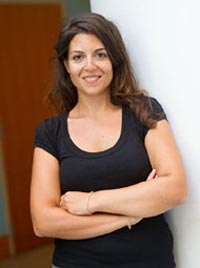This is the latest in a series of profiles of our MIT Energy Fellows—graduate students who are supported by MIT Energy Initiative (MITEI) members to participate in faculty-led research and become part of a long-term community of students and alumni.

Martina Coccia’s childhood visits to Mt. Vesuvius made her wonder what lurked beneath the Earth’s surface that could cause violent occurrences such as volcanic eruptions and earthquakes. Years later, as a student at Rome’s Sapienza University, she decided to study geology to find out.
Now, with a master’s degree in geophysics, geodynamics, and volcanology, she hopes to take her work to another level: exploring how underground formations could be tapped for geothermal heat and other energy-related applications.
Coccia is an MIT Energy Fellow sponsored by Eni S.p.A., a founding member of the MIT Energy Initiative (MITEI). Working with Thomas A. Herring, professor of Earth, Atmospheric, and Planetary Sciences (EAPS), she said, “My interests are broadly in crustal deformation such as seismology, and applying geophysics techniques to monitoring reservoirs or exploring potential geothermal sources.” She has used geophysics to image and monitor underground formations and to model and simulate geological systems.
“After my graduation from the university in Rome, I attended seminars by people who work in the energy field and I became interested in it,” she said. “It’s a new challenge today for researchers in this field. I have worked on geophysical formations in general, but this kind of thing could be applied to geothermal exploration or monitoring. I hope my research will be useful in advancing the field of geophysics and in terms of energy needs and energy savings.”
Herring studies high-precision geodetic measurement systems to monitor deformations both globally and in selected regions around the world. His methods include the Global Positioning System (GPS); Very Long Baseline Interferometry (VLBI), which combines astronomical observations of an object made simultaneously by different sources; and Satellite Laser Altimetry, which directly measures the elevation of terrain from an aircraft or a satellite.
Risky business
In Italy, Coccia studied earthquake fault lines under the Southern Alps and Dinarides mountains, located in northeast Italy and northwest Slovenia. She collected GPS measurements of the area, the site of a major earthquake in the 1970s, to see if anything could be inferred about the risk of another quake.
“The eastern region of the Southern Alps is one of the most seismically active regions of Italy,” she said. “Because of the high population density and density of industrial settlements, the region is highly vulnerable to earthquakes.”
Born in Milan, Coccia moved at age 13 with her family to Giulianova, a little town on central Italy’s east coast. After becoming interested in seismology in high school, she enrolled in the University of Rome, known as La Sapienza, an enormous university steeped in history. There she sat in on seminars that awakened her interest in energy. Her thesis advisor, a visiting professor now with the US Geological Service, suggested she apply to MIT.
She’s glad she did. “The EAPS department at MIT is a leader in the field. The program is really interesting and stimulating,” she said.
“The thing that most intrigues me is that today’s global energy situation is the challenge of our generation,” she said. “The most exciting things for me about working in energy at MIT is that you can work in an interdisciplinary program and combine theoretical aspects of the field with applications to real problems such as energy issues. I hope my research will contribute to meeting the growing demand for energy and promote sustainable development worldwide.”
Press inquiries: miteimedia@mit.edu